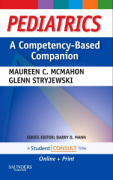
Pediatrics a competency-based companion: with student consult online access
Mcmahon, Maureen C.
Stryjewski, Glenn
Pediatrics: A Competency-Based Companion, by Maureen C. McMahon, MD and GlennStryjewski, MD, MPH, is designed to teach you to think like an experienced clinician. The only text written in the framework of the Core Competencies developed by the ACGME, its case-based approach illustrates the thought processes that effective practitioners use to approach and evaluate common pediatric presentations. Learning is easy through an intuitive, practical organization a concise, high-yield presentation graphs, tables, and other at-a-glance features, such as Professors' Pearls" that provide cases with questions and annotated answers and a framework that allows you to track your progress and that of your patients in relation to ACGME and AAMC expectations. A convenient pocket-sizedformat enables you to review the material on the go, and online access via Student Consult includes online extras such as "Integration Links" to bonus content in other Student Consult titles, a Competency Self-Assessment Log, Vertical Reads, and much more. INDICE: Section I: INTRODUCTION TO THE COMPETENCIES 1 How to Study This Book 2 Medical Knowledge 3 Patient Care 4 Professionalism 5 Interpersonal and Communication Skills 6 Practice-Based Learning and Improvement 7 Systems-Based Practice 8 How to Succeed in the Pediatric Clerkship 9 How to Succeed as a Junior Resident: Continuity Clinic and Inpatient Wards 10 History Taking and Physical Examination 11 Note Writing 12 Oral Presentations Appendix 1 ACGME Clinical Competencies Appendix 2 Competency Self-Assessment Form: Pediatrics Online Appendices Appendix 1 Competency Based Career Planning Appendix 2 Organization and Time Management Appendix 3 Non-Clinical Activities Section II: THE OUTPATIENT OFFICE Well Child Care 13 Essentials of the Pediatric Well Child Visit 14 Developmental Screening and Surveillance 15 Anticipatory Guidance 16 The Newborn Well Child Visit 17 Hip Examination Teaching Visual 18 The One, Two and Four Month Well Child Visits 19 The Six Month Well Child Visit 20 The Nine Month Well Child Visit 21 The 12 Month Well Child Visit 22 The 18 and 24 Month Well Child Visits 23 The Annual Well Child Visit 24 The Adolescent Well Child VisitDevelopmental Problems 25 The Special Needs Child 26 Autism 27 Attention Deficit/Hyperactivity Disorder (Case 1) 28 Down Syndrome Episodic Care 29 Preparticipation Physical Examination 30 Sore Throat (Case 2) 31 Cough (Case 3) 32 Headache in Childhood (Case 4) 33 Eye Pain and Discharge (Case 5) 34 Diarrhea (Case 6) 35 Constipation (Case 7) 36 Fever (Case 8) 37 Ear Pain (Case 9) 38 Examination of Middle Ear Teaching Visual 39 Weight Gain (Case 10) 40 Feeding Difficulty (Case 11) 41 Dysuria (Case 12) Professor's Pearls: The Outpatient OfficeSection III: THE INPATIENT WARD 42 Family-Centered Care 43 Fever and Rash (Case 13) 44 Difficulty Breathing (Case 14) 45 Anemia (Case 15) 46 Neonatal Fever(Case 16) 47 Seizure (Case 17) 48 Apparent Life-Threatening Event (Case 18) 49 Meningitis (Case 19) 50 Lumbar Puncture Teaching Visual 51 Skin and Soft Tissue Infections (Case 20) 52 The Limping Child (Case 21) 53 Salter-Harris Teaching Visual Professor's Pearls: The Inpatient Ward Section IV: THE NEWBORN NURSERY 54 The Newborn Examination 55 Dysmorphology 56 Infant Feeding 57 Newborn Screening 58 Newborn Hearing Screen 59 The Late Preterm Infant 60 Jaundice (Case 22) 61 Feeding Difficulty in the Newborn (Case 23) 62 Abnormal Newborn Hearing Screen (Case 24) 63 Early Onset Group B Streptococcal Disease (Case 25) 64 Delayed Meconium Passage (Case 26) 65 Antenatal Hydronephrosis (Case 27) 66 The Newborn with a Murmur (Case 28) 67 Transient Tachypnea of the Newborn (Case 29) 68 Neonatal Hypoglycemia (Case 30) Professor's Pearls: The Newborn NurserySection V: THE NEONATAL INTENSIVE CARE UNIT 69 Delivery Room Management of the Newborn Infant 70 The Preterm Infant 71 The Growth Restricted Infant 72 Follow-Up Care of the Premature Infant 73 Necrotizing Enterocolitis (Case 31) 74 Respiratory Distress Syndrome (Case 32) 75 Congenital Diaphragmatic Hernia (Case 33) 76 Tracheo-Esphageal Fistula (Case 34) 77 Meconium Aspiration Syndrome (Case 35) 78 Neonatal Sepsis (Case 36) 79 Neonatal Herpes (Case 37) 80 Intraventricular Hemorrhage (Case 38) 81 Cyanotic Newborn (Case 39) 82 Patent Ductus Arteriosus Teaching Visual Professor's Pearls: The Neonatal Intensive Care UnitSection VI: THE PEDIATRIC INTENSIVE CARE UNIT 83 Raised Intracranial Pressure(Case 40) 84 Arrythmia (Case 41) 85 Acute Respiratory Failure (Case 42) 86 Shock (Case 43) 87 Diabetic Ketoacidosis (Case 44) 88 Trauma (Case 45) 89 StatusAsthmaticus (Case 46) 90 The Chronic Child (Case 47) 91 Status Epilepticus (Case 48) 92 Myocarditis (Case 49) Professor's Pearls: The Pediatric Intensive Care Unit Section VII: THE EMERGENCY DEPARTMENT 93 Focused Evaluation of the Emergent Pediatric Patient 94 Dehydration (Case 50) 95 Lumps and Bumps (Case 51)96 Abdominal Pain (Case 52) 97 Chest Pain (Case 53) 98 Physical Abuse (Case 54) 99 Pediatric Poisonings (Case 55) 100 Petechial Rash (Case 56) 101 Animal Bite (Case 57) Professor's Pearls: The Emergency Department Section VIII: APPLICATIONS AND CHALLENGES 102 Giving Bad News 103 Difficult Encounters 104 Teamwork and Communication 105 Patient Safety 106 Informed Consent 107 Ethics in theNICU: The Limits of Viability 108 Immunization Refusal 109 A Pediatrician in Haiti
- ISBN: 978-1-4160-5350-7
- Editorial: Saunders
- Encuadernacion: Rústica
- Páginas: 856
- Fecha Publicación: 30/06/2011
- Nº Volúmenes: 1
- Idioma: Inglés
